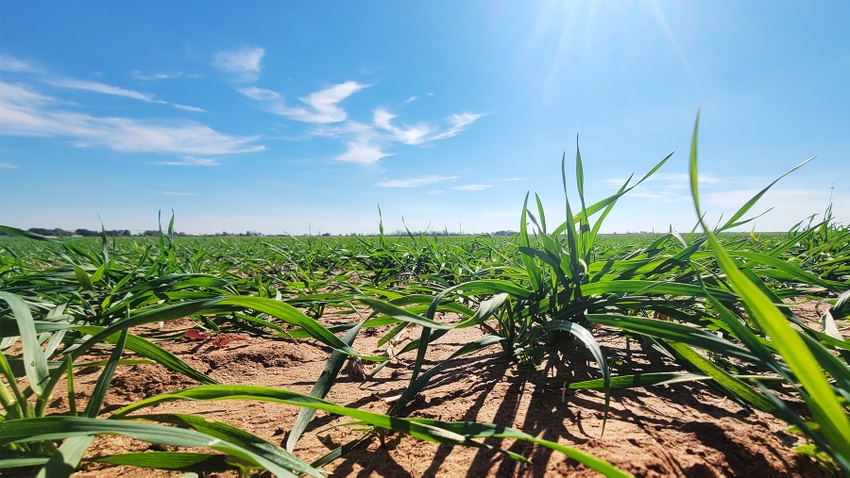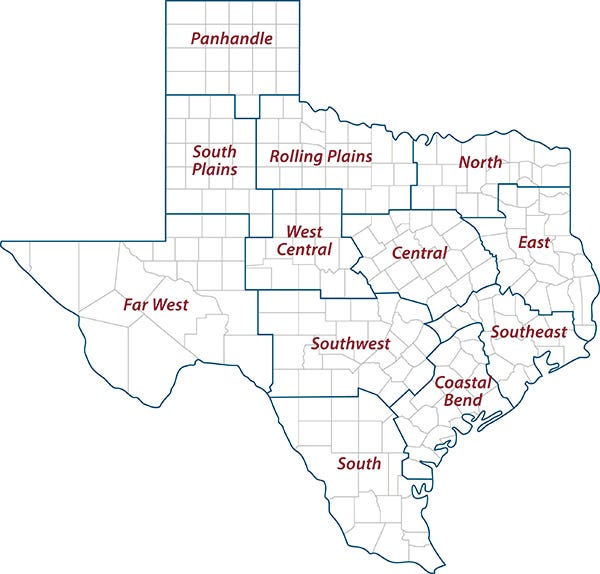
Recent rainfall and cooler temperatures allowed Texas producers to plant cool-season crops and get root systems established before winter, said a Texas A&M AgriLife Extension Service expert.
Brighter outlook
Throughout the last week, different areas across the state other than the Far West and Panhandle regions, received around 2 inches of rain on average, with some areas getting 3 to 5 inches of rain.
William Baule, Texas A&M University Department of Atmospheric Sciences regional climatologist at the Southern Regional Climate Center, said forecasts called for more rain and colder temperatures, which will continue to improve soil moisture conditions.
“Coming out of the second hottest summer for Texas, we have seen warmer-than-average temperatures until now,” Baule said. “But we’re seeing better weather trends for much of the state going into winter.”
Entering the winter season, outlooks are showing an equal chance for above or below-normal temperatures, with a higher probability for precipitation entering into the El Niño pattern.
Beneficial weather changes
An extremely dry and hot summer was followed by an abnormally dry fall, said Reagan Noland, AgriLife Extension agronomist, San Angelo.
“We usually have rain in late August and throughout September that helps finish our cotton crop and prepare for winter crops,” he said.
This year, though, the lack of rainfall, coupled with heat stress through the late summer months and into the fall, resulted in much of the cotton acreage failing or with extremely low yields.
“Irrigated crop systems in this region usually maintain productivity in dry years,” Noland said. “But coming out of a three-year drought, our irrigation water was depleted and couldn’t keep up with demand.”
The recent rainfall brought producers some relief and allowed them to plant winter crops like wheat. They hope the El Niño pattern will continue to deliver above-average moisture, Noland said.
“This rainfall is tremendous for our winter crops,” Noland said. “It’s too late for the cotton, and a bit late for fall and winter grazing, but will provide our producers the soil moisture needed to get winter wheat established and off to a good start.”
AgriLife Extension district reporters compiled the following summaries:

CENTRAL
There were 2-20 inches of rain reported. Rainfall filled tanks, creeks and rivers while producing good soil moisture. By the end of the week, some large reservoirs had risen by a couple of inches. Standing water had been observed in pastures. One county reported a population increase of armyworms in isolated areas. Some areas only received a small amount of rain and while there was some green growth, producers lost a hay crop and a large amount of grazing. Some producers planted small grains and ranchers were working to finish planting winter pastures for grazing. Producers were planting wheat and oats. Oats already planted for grazing were expected to have enough moisture to emerge. Early fall-planted grazing winter oats and ryegrass were looking good. A portion of winter wheat had yet to be planted to avoid attracting the early egg-laying population of the Hessian fly. Livestock remained in good body condition, with producers feeding hay and supplements. Stock numbers in pastures appeared lower than in previous years.
ROLLING PLAINS
Much-needed rain fell last week. Rain totals varied from county to county, but most areas received a minimum of 2 inches. Some counties reported pockets of up to 7 inches of total rainfall. This rainfall benefitted freshly planted winter wheat, and producers were hopeful this would put the crop in a positive pattern going into winter. The rains also improved pasture grass for livestock grazing. Tanks for livestock drinking water were reported as mostly full.
COASTAL BEND
Scattered showers were received and helped retain what soil moisture was available. Producers were caught up on most operations, and most fields were in good shape with disking and bedding up rows. Many producers were getting ready to begin fertilizing. Some second crop rice was harvested. Winter pasture planting continued. Fall armyworm activity was reported. Some hay was still being cut and baled. Pasture conditions improved slightly, but with cooler temperatures grasses were expected to slow in growth rate. Livestock prices were still strong in local auctions.
EAST
Recent rainfall improved conditions across the region. Polk County reported that Lake Livingston was still very low and some boat ramps and docks were closed. Marion County reported receiving as much as 3.5 inches of rainfall. Pasture and rangeland conditions were poor to good. Subsoil and topsoil conditions were adequate. Livestock were in fair to good condition, with supplementation taking place. Hay shortage continued to be a primary concern for producers. Armyworms continued to be a problem.
SOUTH PLAINS
Across the district, rain totals ranged from 1 to 1.5 inches, delaying cotton stripping across the county. Producers were looking forward to the possibility of frost this weekend to help with defoliating cotton so it can be harvested. Gins were busy with the cotton they received before the rainfall. Winter wheat improved over the past week. Wheat planting will continue once conditions dry up. Cattle were reported to be in good condition.
PANHANDLE
The region experienced dry conditions, colder temperatures and a killing freeze, but no moisture. The cotton crop was at final maturity with a high percentage of bolls open, and stripping was expected to begin soon. Wheat planting and corn harvest were completed except for a few fields. Grain sorghum was sampled with very little harvested. The remaining acres of forage sorghum were being chopped directly or windrowed for chopper pickup. Fall tillage was underway on many acres harvested for silage. Cover crops were planted on many of the same acres harvested for silage.
NORTH
Topsoil and subsoil were reported as short to very short in most counties, with few counties reporting as adequate and surplus. The weather significantly changed across all counties, with many receiving less than 1 inch of rain. Cracks in the ground were gone, ponds were full or close to full, and below-freezing temperatures were projected in the next week. Winter wheat was planted, and livestock were in good condition.
FAR WEST
Several beneficial rains swept the area over the past week. Totals were in the 0.2-to-5 inch range. Most of the week, daytime temperatures were in the mid-70s to upper 80s, with overnights in the upper 40s to the mid-70s. Cotton harvest continued with very disappointing yields, as well as being stalled due to wet fields. Wheat planting continued. The rain improved small-grains growing conditions. Most cotton fields were shredded and plowed under. Haygrazer was doing well. Pumpkin production was going well. Soil moisture levels were ranging from adequate to surplus this week. Livestock were in fair condition. Producers were supplementing with hay and grain. Some producers were in the process of hog-proofing their property as much as possible.
WEST CENTRAL
A few thunderstorms swept the district, bringing anywhere between 3-8 inches of rain in some areas. This soil moisture allowed oat and wheat crops to be planted and established in the soil. Some hay producers were completing their final cut of hay. Irrigated cotton producers were applying harvest aids. Cotton was in poor condition and very few acres were harvested. Winter wheat was in good condition and will continue to benefit from recent rains. Rangeland and pastures were improving. Supplemental feeding continued for cattle herds. Local cattle markets have slowed down, and prices remain high.
SOUTHEAST
Adequate rainfall across the area left pastures well-saturated. Fieldwork was not able to be done in some areas due to flooding. Soil-moisture levels ranged from adequate to very short. Cotton harvest was almost completed. Producers started planting winter wheat for both grain and forage. Some producers got a last-minute hay cutting. Dryland was averaging a half bale to 1 bale per acre. Cattle markets were slowing down as producers stopped culling their herds.
SOUTHWEST
The district received an average of 5 inches of rain, with an accompanying cold front dropping temperatures to the mid-40s. Winter wheat was slow to start but will benefit from recent rainfall. Winter weeds were beginning to emerge in bare ground. Cotton harvest was in progress. Rangeland and pasture conditions were still primarily poor. Pecan orchards were preparing for harvest, with a few minor cases of pecan scab in some orchards. Livestock markets remained steady to higher for cattle but low for sheep and goats. Producers continued supplemental feeding for livestock throughout the district. Deer were reported to be in good shape.
SOUTH
Temperatures dropped, and moisture swept across the area. Strawberry planting was in full swing. Harvest of peanuts and fall sorghum began. Citrus and sugarcane crops were being harvested. Cotton harvest was completed. Winter wheat crops were planted with many already emerging. Pastures and rangelands were improving with the rain, but more was needed as they entered their winter dormancy period. Producers slowed culling their herds and continued supplemental feeding. Hay supplies were short, and many were concerned that there would not be enough for the coming winter season. Local beef markets reported above-average volumes with solid prices for all classes of beef cattle. White-tailed deer were moving, sights of wildlife were increasing, and deer and quail hunters were expecting a good season.
About the Author(s)
You May Also Like




